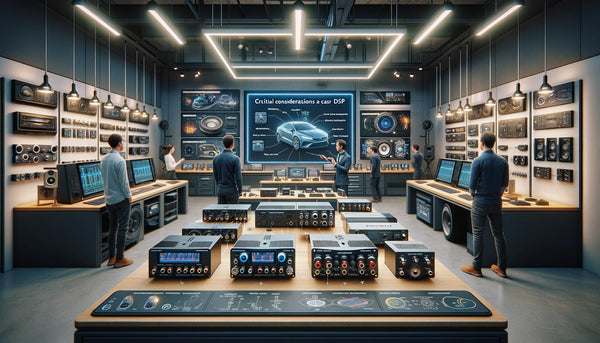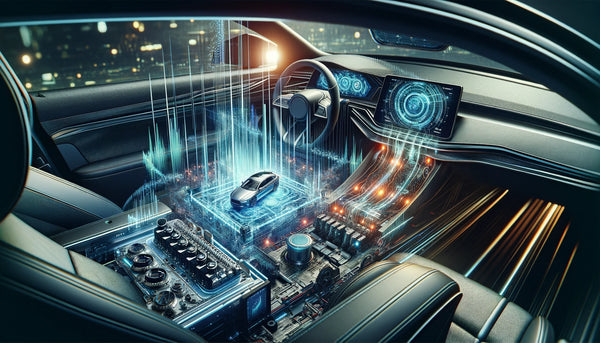Car audio enthusiasts continually seek methods to elevate their system's sound quality, and one of the pivotal advancements in achieving audiophile-level acoustics in vehicles is through car audio DSP integration. A digital signal processor (DSP) is the cornerstone for refining audio output, enabling meticulous manipulation of sound waves to produce crystal-clear audio that resonates with precision and depth. This comprehensive guide aims to demystify integrating a DSP into your car's audio setup, presenting a step-by-step approach that caters to both novices and seasoned audiophiles.
Delving into car audio DSP integration unveils a transformative approach to enhancing your vehicle's sound system. By incorporating a DSP, you gain unprecedented control over every nuance of sound processing, from equalization to spatial sound distribution. This handbook will guide you through the intricacies of DSP technology, from basic connections using factory stereo outputs to advanced configurations accommodating high-power factory amplifiers. Regardless of your experience level, understanding the impact of a DSP on your car audio system is the first step towards achieving an immersive auditory experience that mirrors concert hall acoustics.
Learn how to integrate DSP into your car audio system seamlessly. Detailed guidance awaits in Discover the World of Car Audio DSP.
Understanding the Need for a Digital Signal Processor in Car Stereos

In the past, integrating advanced audio technology with factory radio systems often resulted in less-than-ideal sound output due to the limitations of analog signal processing. However, introducing digital sound processors (DSPs) has revolutionized the car audio landscape, offering an enhanced user experience with superior audio experience.
DSPs enable meticulous manipulation of audio frequencies, elevating audio performance, clarity, and bass depth. When considering integrating these powerful devices, the focus shifts to the various input channels for routing audio signals into the DSP. The most prevalent method involves line output converters and RCA outputs, facilitating seamless OEM integration by connecting the DSP to an aftermarket head unit. This setup not only ensures a sufficient amount of power for system performance but also provides the flexibility needed for system tuning through multiple output channels.
The shift from Analog to Digital Audio in Car Stereos
The shift from analog to digital in car audio systems marks a significant milestone, setting a new gold standard for car audio enthusiasts. Digital sound processing ushers in an era of unparalleled control and versatility, leading to a precise soundstage, enhanced bass response, and a more enveloping overall audio experience. Thanks to digital audio processing, car audio setups now offer an audio performance that competes with professional audio systems found in home entertainment setups, delivering a superior audio experience that transforms the in-car listening environment.
The role of Digital Sound Processing in improving Audio Quality
Digital sound processing plays a crucial role in elevating the sound characteristics of car audio systems. By employing advanced DSP software algorithms, digital sound processors meticulously refine audio fidelity, curtail distortion, and boost overall system performance. This granular control over equalization, crossover filters, and time alignment enables enthusiasts to customize their audio setup for precise and immersive sound output.
DSP technology is pivotal in audio compression and streaming, facilitating efficient audio data management. DSP algorithms compress audio files for streamlined transmission and support various digital formats such as MP3, AAC, and FLAC. This ensures an optimal balance between file size and audio quality, essential for maintaining high-quality sound in streaming services, online radio, and digital platforms, thus significantly enhancing the user experience in audio streaming and distribution.
When choosing a DSP

When selecting a digital signal processor for your car audio setup, it's essential to consider various key factors to ensure the DSP aligns with your system's needs and delivers the desired sound quality. Considerations such as the number of input and output channels are vital for accommodating the complexity of your system and facilitating precise system tuning.
Additionally, the availability of crossover filters and equalization options is crucial in tailoring the sound output to your preferences. It's also essential to evaluate the DSP's compatibility with your existing factory radio or aftermarket head unit, ensuring seamless integration. Finally, assessing the DSP's software capabilities for user-friendly customization can significantly enhance your system's overall audio experience, allowing for a tailored audio environment that meets your specific listening preferences.
Features to look for in a DSP
When choosing a digital signal processor, closely scrutinizing its features for precise audio signal control is paramount. Key among these features are the crossover point adjustments, crucial in optimizing sound quality. These adjustments enable the DSP to channel specific audio frequencies to suitable speakers, such as tweeters for high frequencies, thereby ensuring a precise and balanced soundstage.
Moreover, ensuring compatibility with aftermarket components like car speakers, subwoofers, and dsp amplifiers is essential for seamless OEM integration into your current audio setup. This compatibility ensures that the DSP can effectively work with various components to enhance the overall audio experience, making it a powerful package for superior sound quality and system performance.
Decoding DSP Controls - Knobs or Software?
Digital signal processors offer diverse control mechanisms, each with its distinct advantages. Analog knobs deliver a tactile user experience, enabling immediate and precise adjustments, essential for on-the-go fine-tuning of sound characteristics.
Conversely, software interfaces unlock advanced control features, such as customizable equalization curves, detailed time alignment, and intricate crossover settings, enhancing the audio system's precision and flexibility.
Additionally, specific digital sound processors extend the convenience of remote control via smartphone apps, allowing for effortless setup and adjustment, thereby significantly improving the user experience with their accessible and intuitive control options.
Understanding the Power Option in DSP
When evaluating the power capabilities of a digital signal processor, it's essential to consider its amplification potential. DSPs with integrated amplifiers offer a streamlined setup, merging signal processing and amplification into a single unit, which can simplify the installation process. On the other hand, DSPs designed with external amplifiers allow for more tailored control over the amount of power delivered to each speaker, ensuring optimal audio performance tailored to your system's specific needs.
If your audio setup demands both amplification and advanced signal processing, consider high-tech amplifiers that incorporate full-featured DSPs within their design. This powerful combination can provide a comprehensive solution, eliminating the need for separate components. However, it's crucial to match the amplifier's output power with the capabilities of your speakers, like adjusting the output to -6 dB FS when using a speaker that handles less power than the amplifier can deliver, to ensure precise soundstage without overpowering the speakers.
The Technical Aspects of a DSP

To truly tap into and leverage the full capabilities of a digital signal processor (DSP), gaining a deep understanding of its technical facets is paramount.
This journey of discovery begins with unraveling the complexities of equalization (EQ). EQ is a vital tool in the DSP arsenal, allowing for the meticulous adjustment of various frequency bands within your car audio system.
By mastering EQ settings, you can sculpt the audio output to suit your taste, enhancing specific frequencies while dampening others to achieve the perfect sound balance.
In addition to EQ, comprehending the concept of time alignment is crucial in maximizing the potential of your car audio system. Time alignment, an advanced feature of DSP, involves adjusting the timing of audio signals from each speaker to reach the listener's ears simultaneously.
This is particularly important in a car environment, where speakers are unevenly spaced around the cabin. Proper time alignment ensures a more cohesive and harmonious soundstage, making it feel like the music comes from a central point before you rather than being scattered around the vehicle.
You can transform your car's audio system into a finely tuned sonic machine by delving into these technical aspects and harnessing the power of EQ and time alignment. This elevates your listening experience and brings out the best in your music, podcasts, or any other audio content you enjoy while on the road.
The knowledge and application of these DSP features enable you to create a custom, concert-like audio environment in your car, making every journey a rich and immersive auditory experience.
Unraveling Equalization (EQ) in DSP
Equalization, or EQ, is vital in-car audio digital signal processing. It allows for adjustments to sound frequencies, compensating for audio system and environmental limitations. Precise equalization control enables car audio enthusiasts to fine-tune their sound system, optimizing sound quality, clarity, and bass response.
Concept of Time Alignment in DSP
Time alignment is essential to car audio digital signal processing, ensuring precise audio signal delay for optimal sound quality. By adjusting audio signal delay, car audio enthusiasts can achieve a proper soundstage, enhancing audio clarity and imaging. Understanding time alignment algorithms and their impact on soundstage and clarity is critical to maximizing the potential of your car audio system.
Advancing your Car Audio with a DSP

Incorporating a digital signal processor (DSP) into your car's audio system is a transformative step that can elevate your audio experience to unparalleled heights. Integrating a DSP profoundly impacts car audio systems, revolutionizing how sound is managed and delivered within the vehicle.
By enhancing sound quality, fidelity, and bass response, a DSP brings a level of audio clarity and depth that is truly exceptional.
The capabilities of a DSP in a car audio system are multifaceted. It meticulously processes and refines the audio signal, ensuring that each note and beat is precisely reproduced. Whether you're listening to music, a podcast, or an audiobook, the DSP ensures that the sound is crisp, clear, and full of life. Furthermore, the enhancement in bass response provided by a DSP is particularly noteworthy. It allows for a richer, more robust bass that resonates perfectly within the confines of your vehicle, providing a more immersive and enjoyable listening experience.
Another key advantage of integrating a DSP is its precise control over audio calibration. With a DSP, you can tailor the audio output to suit your personal preferences and the unique acoustics of your car. This includes adjusting equalizer settings, fine-tuning the balance and fade, and compensating for any speaker placement asymmetries. The result is a customized audio environment that feels personally crafted for you and your vehicle.
Overall, adding a digital signal processor to your car's audio system is not just an upgrade; it's a complete transformation of your in-car audio experience. It provides a level of sound quality and control that turns every drive into an opportunity to enjoy your favorite audio content in the best possible way.
The Impact of DSP on Car Audio Systems
DSP integration optimizes audio signals, producing better sound quality in-car audio systems. Distortion-free, high-fidelity audio becomes achievable, providing a more immersive audio experience. With precise control over audio equalization, crossover, and time alignment, car audio enthusiasts can overcome audio system limitations, delivering superior sound quality.
Benefits of Using DSP in Car Audio Systems
Using a digital signal processor in-car audio systems offers numerous benefits, including precise control over audio system calibration and enhanced sound quality, fidelity, and bass response. With distortion-free audio, car audio enthusiasts can enjoy an unparalleled listening experience even at high sound levels. Interestingly, a close look at the specifications for many of the DSP ICs available on the market shows a reduction in signal-to-noise ratio when the bandwidth is increased to include audio above 22 kHz.
This highlights the importance of considering the specifications of the DSP ICs when integrating them into car audio systems. The enhancement of sound quality, fidelity, and bass response, along with the attention to specifications, makes DSP a must-have for car audio enthusiasts.
The Future of DSP in Car Audio

The future of car audio is evolving, with digital signal processing (DSP) playing a significant role. Leading car audio brands like Alpine, Sony, and AudioControl are at the forefront of the DSP revolution, offering industry-leading solutions for car audio applications. These brands provide precise control, compatibility, and audio quality, making them highly recommended by industry experts. DSP integration is becoming more common as car audio brands incorporate it into their audio systems.
Brands that are leading the DSP revolution
Brands like Alpine, Sony, and AudioControl have become household names in the car audio industry, known for their industry-leading DSP solutions. Arc Audio, AudioControl, and Alpine offer digital signal processors with precise control, compatibility, and superior audio quality. These brands provide car audio enthusiasts with the tools to optimize their sound system, delivering unparalleled sound quality.
How is DSP changing the future of Audio? (Question)
Digital signal processing (DSP) modules are transforming the future of car audio by providing precise tuning and customization of sound. With DSP modules, car audio systems can correct acoustic issues within a car's interior, achieving even frequency response and minimizing resonance. Integrating DSP modules into car audio systems enhances clarity, detail, and soundstage, even in noisy environments. Drivers and passengers can enjoy an enhanced listening experience thanks to the advancements in DSP technology.
Frequently Asked Questions

What are crossover point adjustments for car audio systems in a digital signal processor?
Crossover point adjustments in a digital signal processor (DSP) are crucial for optimizing sound quality in car audio systems. These adjustments allow the DSP to direct specific audio frequencies to the most appropriate speakers, such as sending higher frequencies to tweeters and lower frequencies to woofers or subwoofers. By fine-tuning these crossover points, users can achieve a more precise and balanced audio output, ensuring that each speaker operates within its optimal frequency range. This results in clearer, more defined sound reproduction and enhances the overall listening experience in the vehicle.
How do software control options enhance the car audio system's performance?
Software control options in digital signal processors offer advanced capabilities for customizing and optimizing the car audio system's performance. These options include detailed equalization settings, allowing users to adjust frequency response curves for perfect tonal balance; time alignment features, which synchronize the sound from each speaker to arrive at the listener's ears simultaneously, creating a cohesive soundstage; and intricate crossover settings for precise speaker frequency division.
Moreover, some DSPs offer smartphone app compatibility, making it convenient for users to adjust settings and fine-tune their audio system remotely. These advanced software controls enable enthusiasts to tailor their car audio systems to their vehicles' personal preferences and acoustic characteristics, significantly enhancing the overall audio experience.
Can DSP be integrated into any car audio system?
DSP can be integrated into most car audio systems, but compatibility and system requirements should be considered. Consulting with a professional installer is recommended to determine the best integration options for your specific car audio system. Proper integration of DSP can significantly enhance sound quality, clarity, and bass response, resulting in an optimized audio experience.
Conclusion
In conclusion, integrating a digital signal processor (DSP) into your car's audio system can significantly enhance your listening experience. With the ability to manipulate and fine-tune audio signals, a DSP allows precise control over equalization and time alignment, resulting in improved sound quality and imaging. When choosing a DSP, consider essential features such as EQ capabilities, power options, and control interfaces.
DSP in-car audio systems are on the rise, with leading brands revolutionizing the industry. As technology continues to advance, the future of Audio lies in the integration of DSP. Not all car audio systems may be compatible with a DSP, so it is essential to consult with a professional or refer to manufacturer guidelines.
To learn more about the emerging trends and future of DSP in car audio, redirect to our related blog posts.
Choose The Best DSP Car Audio Processor
DSP Vs. Traditional Car Audio: Which Is Better?





